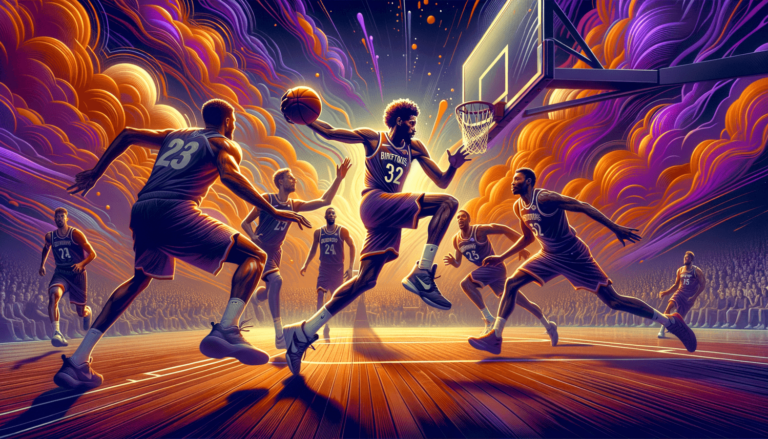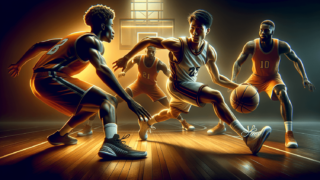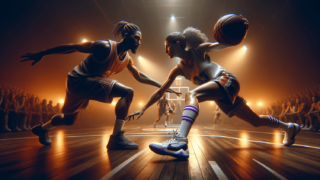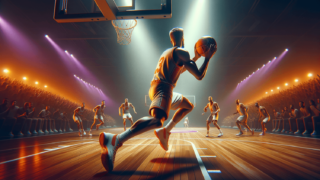
Welcome to the mesmerizing world of basketball, where players perform gravity-defying dunks, astonishing passes, and some of the most breathtaking, earth-shattering post moves! If the mere mention of the term ‘post move’ has left you curious for more, you’re in for a slam-dunk surprise. In this blog post, we will provide an all-access pass to understanding the ins and outs of post moves in basketball, delving deep into their origin, variations, and some of the iconic players who’ve mastered this arsenal of skills. So tighten your sneakers and get ready to shoot, score, and soar like never before!
What’s a Post Move in Basketball?
A post move in basketball refers to a set of offensive techniques executed within or around the post, the area close to the basket. These moves, typically performed by post players or big men, involve positioning oneself with the back or side towards the basket, then using footwork, body control, and deception to create scoring opportunities. Post moves often include hook shots, drop steps, up-and-under, fadeaway shots, and spin moves, among others. Mastering post moves is critical for maintaining a well-rounded inside game and creating offensive threats in the paint.
Unlocking the Secrets of Post Moves in Basketball
From legendary big men to today’s versatile power forwards and centers, the best players in the paint have all worked diligently to develop an extensive repertoire of post moves to keep their opponents guessing. In this section, we’ll explore the nuts and bolts of some of the most popular and effective post moves in basketball, helping you gain an edge on the hardwood.
The Art of Establishing Post Position
Before diving into the actual moves, it’s essential to understand the significance of establishing good post position. A player’s ability to position themselves optimally can determine their success in executing post moves effectively. Let’s break down the essential elements of getting yourself in prime position to dominate the low post:
Body Control and Balance
Use your lower body strength to gain an advantage over your defender, keeping your legs shoulder-width apart, and bending your knees slightly for improved balance. Ensure that you remain low and wide, allowing you to maintain a solid base and effectively absorb contact from your opponent without losing your footing.
Location, Location, Location
Ensure that you’re close enough to the basket to be a threat but not so close that you’re susceptible to traps or double teams. A good rule of thumb is to position yourself within the paint, approximately midway between the baseline and the top of the key, to maximize your options for passing, shooting, and making moves.
Sealing the Defender
Keep your back or side to the basket while extending one arm to call for the ball, effectively ‘sealing’ your defender behind you. This gesture creates enough separation between you and your defender to receive the ball and initiate your post moves quickly.
Mastering the Fundamentals: Basic Post Moves
Now that you’re positioned in the low post and ready to attack, it’s time to dive into the core arsenal of post moves that every player should have in their toolkit.
The Classic Hook Shot
A timeless move that remains effective to this day, the hook shot entails spinning away from the defender, keeping the ball high and away from their reach, and finishing with a one-handed shot. The hook shot can be executed with either hand, allowing for a great deal of flexibility and versatility in scoring opportunities.
The Commanding Drop Step
Drop step is a powerful move that capitalizes on the defender’s positioning, forcing them to make a decision. With your back to the basket, take a quick step towards the baseline, pivoting on your other foot simultaneously, and drop your shoulder under your defender to create space for an easy layup or dunk.
The Cunning Up-and-Under
A move designed to deceive the defender, the up-and-under is executed by faking a shot near the basket to bait your defender into committing. Once they have left their feet, quickly step-through or step under the defender for an uncontested shot or layup.
The Stylish Fadeaway Jumper
A popular move among elite post players, the fadeaway jumper involves taking a step back, leaning away from the defender, and shooting. This creates enough separation to get off a clean shot, even against taller or more aggressive defenders.
Advanced Post Moves: Adding Flair to Your Game
Once you’ve mastered the fundamentals, you can begin to experiment with more advanced post moves and footwork tactics that will leave your defenders flustered and helpless.
The Swift Spin Move
The spin move adds an extra layer of deception, as it capitalizes on the defender’s momentum to create a quick and effective scoring opportunity. To execute, catch the ball with your back to the basket, pivot on one foot while stepping around the defender with the other, and finish with a controlled layup, dunk, or shot.
The Dynamic Dream Shake
Popularized by Hakeem Olajuwon, the Dream Shake is a finesse/footwork combo move that leaves defenders in the dust. To perform the Dream Shake, initiate a post move (such as a drop step or up-and-under) and, as the defender reacts, quickly pivot or fake another move, creating enough space for an uncontested shot or layup.
Mikan Drill: Your Road to Inside Scoring Success
Popularized by Hall of Famer George Mikan, the Mikan Drill focuses on developing touch and accuracy in close-range shots, which are crucial for post players. To practice the drill, stand under the basket and alternate between left and right-handed layups as quickly as possible, using the backboard and focusing on developing a soft touch around the rim.
Learn from the Legends: Standout Post Players in Basketball History
Some players have built their legacies on their ability to dominate in the post. Their brilliance on the court provides invaluable lessons for aspiring post players looking to add more depth to their game.
Shaquille O’Neal: The Powerhouse
Shaquille O’Neal’s sheer dominance in the paint is legendary, stemming from his incredible combination of size, strength, and agility. Shaq’s drop step, in particular, served as the perfect showcase for his unparalleled power and finesse in the post.
Tim Duncan: The Fundamental Master
Nicknamed “The Big Fundamental,” Tim Duncan’s mastery of post moves is hard to understate. Known for his textbook footwork and precision, Duncan’s signature move was his silky smooth bank shot, which he consistently hit from multiple angles.
Hakeem “The Dream” Olajuwon: The Footwork Maestro
Hakeem Olajuwon’s post moves were a sight to behold, thanks to his unmatched footwork, uncanny balance, and lightning-fast fakes. His iconic Dream Shake left defenders utterly befuddled, quickly earning him a reputation as one of the greatest post players in basketball history.
Bringing It All Together: Application and Practice
Having explored the intricacies of post moves, it’s time to put these valuable lessons to use on the court. It’s essential to incorporate them into your practice routine and consciously develop these skills over time. The best way to hone your post moves is by working on them consistently through repetitions, drills, and game scenarios. Applying these moves in-game, against different defenders and defensive schemes, is pivotal in your quest to become a force to be reckoned with in the paint.
Boost Your Post Game: Tips and Tricks for Optimal Success
If you’re eager to make a more significant post-impact in basketball, consider these essential tips and tricks to enhance your on-court prowess.
Strengthen Your Core and Lower Body
Strong core and lower body muscles are vital for effective post play, as they help maintain balance, absorb contact, and generate the force required for those explosive post moves. Incorporating exercises such as squats, lunges, and planks into your workout routine will lay the foundation for your success in the low post.
Develop Both Hands
Being able to execute post moves with both hands will keep defenders guessing and give you an edge in the paint. Focus on strengthening your non-dominant hand by practicing hook shots, layups, and dribbling. Over time, you’ll find yourself ambidextrous and more unpredictable to the opposition.
Keep an Eye on the Weak Side
Good post players are always aware of their surroundings and watch the weak side of the floor for potential help defenders or double teams. By keeping an eye on off-ball movements, you can anticipate defensive rotations and make the right decisions, whether it be a decisive post move or a pass to an open teammate.
Watch Film and Analyze Your Game
To hone your post skills, take the time to study film, including your own games and those of great post players. Analyzing your strengths and weaknesses on tape and identifying the areas you need to work on will help you stay focused during practice sessions and target the aspects that require improvement.
Defense Matters Too: Lockdown Post Defense Tips
While post moves are vital for offensive success, it’s also essential to recognize the importance of being an effective post defender. Let’s cover a few fundamental tips for shutting down your opponents in the low post.
Maintain Good Posture and Position
Good post defenders should mirror the offensive player’s movements and maintain proper body positioning. Keep your knees bent and your arms extended, denying the offensive player the position they desire. Establishing an effective defensive stance will make it challenging for your opponent to make a post move or even receive the ball.
Stay on Your Feet
When defending against post moves, try to stay on your feet and patiently wait to contest the shot. If you jump too early in an attempt to block, you may be susceptible to pump fakes or up-and-under moves, allowing the offensive player to get by easily.
Utilize the Power of Scouting
Effective post defense often requires understanding the tendencies and preferences of your opponents. Take note of their most common moves, preferred shot hand, and areas they’re most comfortable. Use this information to your advantage on the court to anticipate their actions and limit their scoring opportunities.
By complementing your newfound post move prowess with these additional tips, tricks, and defensive strategies, you’ll be well on your way to becoming a complete basketball player, capable of dominating both ends of the court.
Frequently Asked Questions
In this section, we address some of the most commonly asked questions related to post moves in basketball. These FAQs are designed to help further clarify specific aspects, clear up misconceptions, and provide valuable insights to enhance your knowledge about this critical aspect of the game.
1. What’s the difference between a post move and a post player?
A post move refers to an offensive technique used within the post area (close to the basket), typically executed by players in the power forward or center positions. A post player, on the other hand, is a player who specializes in playing close to the basket, often utilizing post moves to score or create opportunities for their teammates.
2. Can guards also benefit from learning post moves?
Absolutely! While post moves are traditionally associated with big men, guards can also benefit from incorporating them into their offensive repertoire. Post moves can be particularly effective for taller guards or ones with a size advantage over their defenders, giving them additional scoring options and making them more versatile offensive threats.
3. Why are some post moves considered outdated or less effective today?
Some post moves may seem outdated due to the evolution of basketball strategy and the increased emphasis on floor spacing and perimeter shooting. However, this doesn’t mean post moves are inherently less effective. For players who excel at post play, mastering these techniques can still provide a significant advantage in creating scoring opportunities and exploiting mismatches against smaller or less mobile defenders.
4. Why is footwork so important for executing successful post moves?
Footwork is the foundation of successful post moves, as it dictates your ability to create space, maintain balance, and deceive your defender. Mastering footwork also allows you to string together multiple moves and counter-moves fluidly, making it harder for the defender to predict your actions and adapt their defense.
5. Can I get better at post moves by practicing alone?
Yes, you can improve your post moves through solo practice. Working on footwork, shooting touch, and individual moves can develop your skills significantly. However, eventually practicing against live defenders is essential for understanding how to read defensive coverages and reacting appropriately to different situations on the court.
6. How can I improve my post passing?
Post passing can be honed by focusing on eye contact, anticipating defensive help, and improving ball-handling skills. Furthermore, learning various post-entry passes, such as the bounce pass, lob pass, or wraparound pass, will help you become a more versatile post passer able to create opportunities for your teammates.
7. Why is core strength crucial for post players and post moves?
Core strength is vital for maintaining balance, absorbing contact, and generating the force required for explosive post moves. A strong core enables post players to hold their ground against defenders and create opportunities by establishing optimal post position and applying force through their moves.
8. Is height a prerequisite for being a successful post player?
While height can be an advantage for post players, there are many instances of shorter players who have excelled in the post position. It’s more critical to possess the necessary skills, footwork, and strength to assert yourself in the low post effectively. With dedication, hard work, and proper technique, you can become an impactful post player regardless of height.
9. How can I practice my post moves effectively?
Effective practice involves watching film, analyzing your game, performing drills, and repetition. Focusing on different aspects of your post game, such as footwork and touch, and consistently working to improve them during practice will lead to a noticeable improvement. It’s also essential to apply your post moves in-game to gain experience against live defenders.
10. Can I use post moves in pick-up games or amateur leagues?
Yes, post moves can be used effectively in pick-up games and amateur leagues. Emphasizing post play can provide a competitive advantage, as many players in these settings often focus on perimeter shooting or isolation play. Mastering post moves allows you to exploit mismatches against smaller or less skilled defenders and create scoring opportunities for yourself or your teammates.
Featured Posts
- No pillar pages found.





